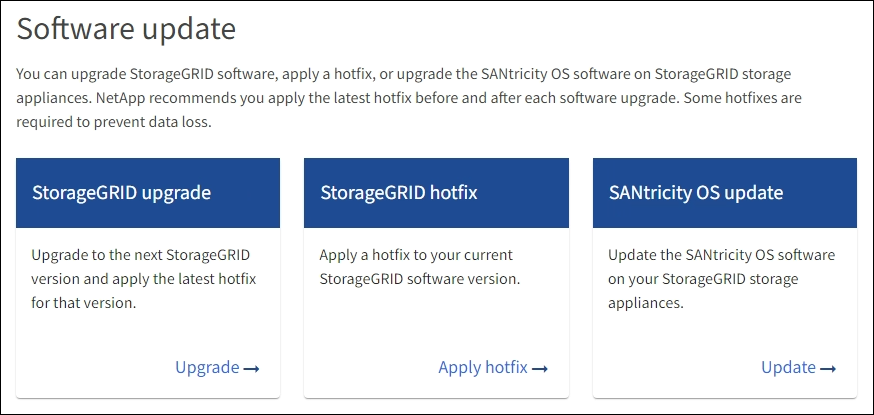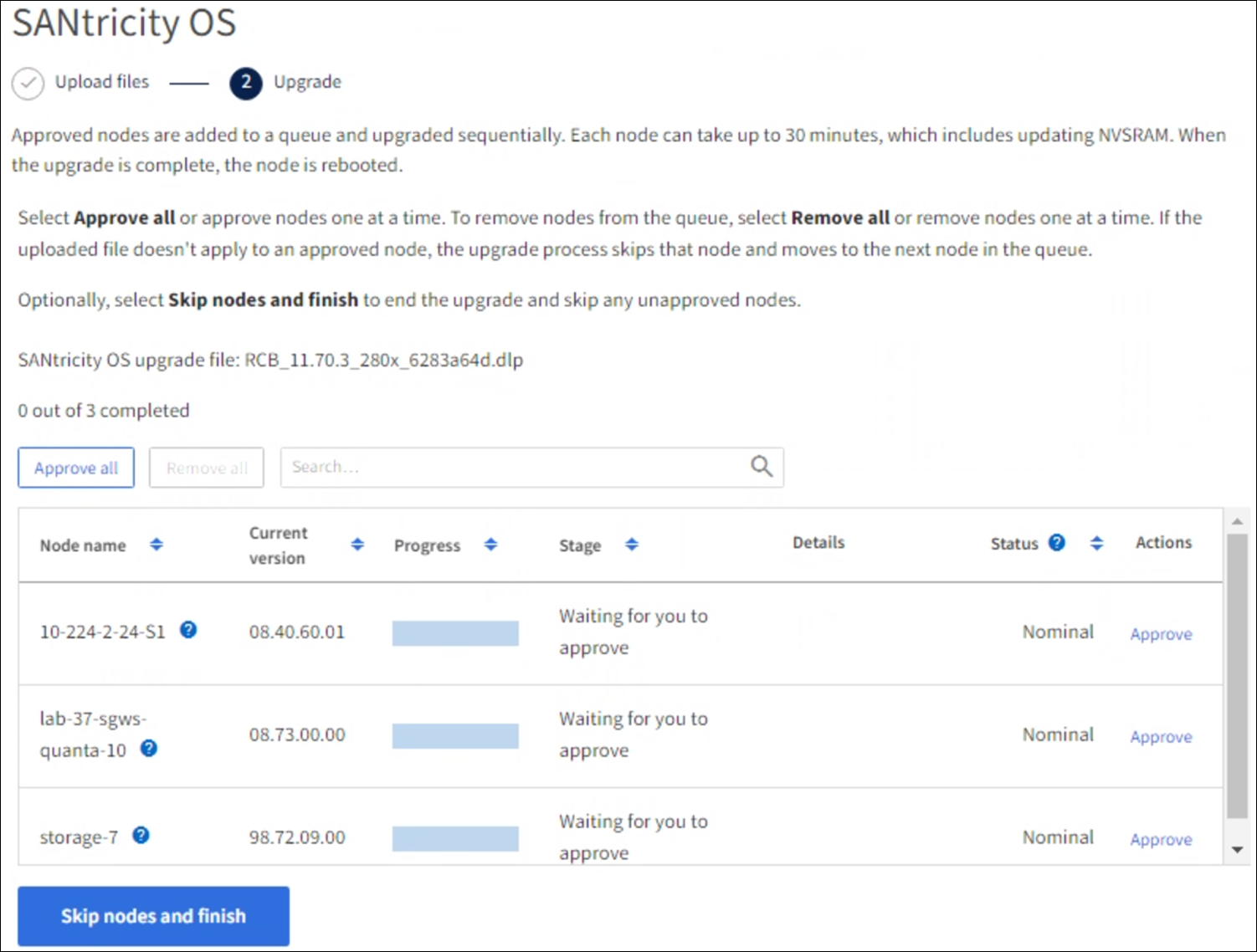Upgrade SANtricity OS on SG6000 storage controllers using Grid Manager
 Suggest changes
Suggest changes


For storage controllers currently using SANtricity OS 08.42.20.00 (11.42) or newer, you must use the Grid Manager to apply an upgrade.
-
If you did not obtain the SANtricity OS version you want to upgrade to from NetApp Downloads: StorageGRID Appliance, you have consulted NetApp Downloads: StorageGRID Appliance or the NetApp Interoperability Matrix Tool (IMT) to confirm that the SANtricity OS version you are using for the upgrade is compatible with your appliance.
-
You have the Maintenance or Root access permission.
-
You are signed in to the Grid Manager using a supported web browser.
-
You have the provisioning passphrase.
You can't perform other software updates (StorageGRID software upgrade or a hotfix) while a SANtricity OS upgrade is in process. If you attempt to start a hotfix or a StorageGRID software upgrade before the SANtricity OS upgrade process has finished, you are redirected to the SANtricity OS upgrade page.
The procedure will not be complete until the SANtricity OS upgrade has been successfully applied to all applicable nodes that have been selected for the upgrade. It might take more than 30 minutes to load the SANtricity OS on each node (sequentially) and up to 90 minutes to reboot each StorageGRID storage appliance. Nodes in your grid that don't use SANtricity OS will not be affected by this procedure.

|
The following steps are only applicable when you are using the Grid Manager to perform the upgrade. The storage controllers in the appliance can't be upgraded using the Grid Manager when the controllers are using SANtricity OS older than 08.42.20.00 (11.42). |

|
This procedure will automatically upgrade the NVSRAM to the most recent version associated with the SANtricity OS upgrade. You don't need to apply a separate NVSRAM upgrade file. |

|
Apply the latest StorageGRID hotfix before you begin this procedure. See StorageGRID hotfix procedure for details. |
-
Download the new SANtricity OS Software file from NetApp Downloads: StorageGRID Appliance.
Choose the SANtricity OS version for your storage controllers.
-
Select MAINTENANCE > System > Software update.

-
In the SANtricity OS update section, select Update.
The SANtricity OS upgrade page appears and lists the details for each appliance node including:
-
Node name
-
Site
-
Appliance model
-
SANtricity OS version
-
Status
-
Last upgrade status
-
-
Review the information in the table for all of your upgradable appliances. Confirm that all storage controllers have Nominal status. If the status for any controller is Unknown, go to Nodes > appliance node > Hardware to investigate and resolve the issue.
-
Select the SANtricity OS upgrade file you downloaded from the NetApp Support Site.
-
Select Browse.
-
Locate and select the file.
-
Select Open.
The file is uploaded and validated. When the validation process is done, the file name is shown with a green check mark next to the Browse button. Don't change the file name because it is part of the verification process.
-
-
Enter the provisioning passphrase and select Continue.
A warning box appears stating that your browser's connection might be lost temporarily as services on nodes that are upgraded are restarted.
-
Select Yes to stage the SANtricity OS upgrade file to the primary Admin Node.
When the SANtricity OS upgrade starts:
-
The health check is run. This process checks that no nodes have the status of Needs Attention.
If any errors are reported, resolve them and select Start again. -
The SANtricity OS Upgrade Progress table appears. This table shows all Storage Nodes in your grid and the current stage of the upgrade for each node.
The table shows all appliance Storage Nodes. Software-based Storage Nodes aren't displayed. Select Approve for all nodes that require the upgrade. 
-
-
Optionally, sort the list of nodes in ascending or descending order by:
-
Node name
-
Current version
-
Progress
-
Stage
-
Status
You can also enter a term in the Search box to search for specific nodes.
-
-
Approve the grid nodes you are ready to add to the upgrade queue. Approved nodes are upgraded one at a time.
Don't approve the SANtricity OS upgrade for an appliance Storage Node unless you are sure the node is ready to be stopped and rebooted. When the SANtricity OS upgrade is approved on a node, the services on that node are stopped and the upgrade process begins. Later, when the node is finished upgrading, the appliance node is rebooted. These operations might cause service interruptions for clients that are communicating with the node. -
Select the Approve All button to add all Storage Nodes to the SANtricity OS upgrade queue.
If the order in which nodes are upgraded is important, approve nodes or groups of nodes one at a time and wait until the upgrade is complete on each node before approving the next node. -
Select one or more Approve buttons to add one or more nodes to the SANtricity OS upgrade queue. The Approve button is disabled if the Status is not Nominal.
After you select Approve, the upgrade process determines if the node can be upgraded. If a node can be upgraded, it is added to the upgrade queue.
For some nodes, the selected upgrade file is intentionally not applied and you can complete the upgrade process without upgrading these specific nodes. Nodes intentionally not upgraded show a stage of Complete (upgrade attempted) and list the reason the node was not upgraded in the Details column.
-
-
If you need to remove a node or all nodes from the SANtricity OS upgrade queue, select Remove or Remove All.
When the stage progresses beyond Queued, the Remove button is hidden and you can no longer remove the node from the SANtricity OS upgrade process.
-
Wait while the SANtricity OS upgrade is applied to each approved grid node.
-
If any node shows a stage of Error while the SANtricity OS upgrade is applied, the upgrade has failed for the node. With the assistance of technical support, you might need to place the appliance in maintenance mode to recover it.
-
If the firmware on the node is too old to be upgraded with the Grid Manager, the node shows a stage of Error with the details that you must use maintenance mode to upgrade SANtricity OS on the node. To resolve the error, do the following:
-
Use maintenance mode to upgrade SANtricity OS on the node that shows a stage of Error.
-
Use the Grid Manager to restart and complete the SANtricity OS upgrade.
-
When the SANtricity OS upgrade is complete on all approved nodes, the SANtricity OS Upgrade Progress table closes and a green banner shows the number of nodes upgraded, and the date and time the upgrade completed.
-
-
If a node can't be upgraded, note the reason shown in the Details column and take the appropriate action.
The SANtricity OS upgrade process will not be complete until you approve the SANtricity OS upgrade on all the listed Storage Nodes. Reason Recommended action Storage Node was already upgraded.
No further action required.
SANtricity OS upgrade is not applicable to this node.
The node does not have a storage controller that can be managed by the StorageGRID system. Complete the upgrade process without upgrading the node displaying this message.
SANtricity OS file is not compatible with this node.
The node requires a SANtricity OS file different than the one you selected. After completing the current upgrade, download the correct SANtricity OS file for the node and repeat the upgrade process.
-
If you want to end approving nodes and return to the SANtricity OS page to allow for an upload of a new SANtricity OS file, do the following:
-
Select Skip Nodes and Finish.
A warning appears asking if you are sure you want to finish the upgrade process without upgrading all applicable nodes.
-
Select OK to return to the SANtricity OS page.
-
When you are ready to continue approving nodes, download the SANtricity OS to restart the upgrade process.
Nodes already approved and upgraded without errors remain upgraded.
-
-
Repeat this upgrade procedure for nodes with a stage of Complete that require a different SANtricity OS upgrade file.
For nodes with a status of Needs Attention, use maintenance mode to perform the upgrade.


